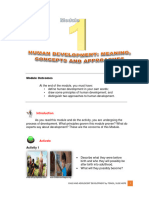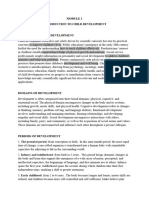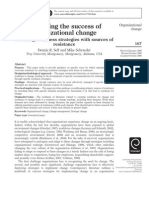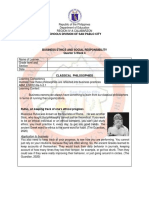Unit 1: Basic Concepts in Child and Adolescent Learners
Unit 1: Basic Concepts in Child and Adolescent Learners
Uploaded by
Marvic AboCopyright:
Available Formats
Unit 1: Basic Concepts in Child and Adolescent Learners
Unit 1: Basic Concepts in Child and Adolescent Learners
Uploaded by
Marvic AboOriginal Title
Copyright
Available Formats
Share this document
Did you find this document useful?
Is this content inappropriate?
Copyright:
Available Formats
Unit 1: Basic Concepts in Child and Adolescent Learners
Unit 1: Basic Concepts in Child and Adolescent Learners
Uploaded by
Marvic AboCopyright:
Available Formats
The Child and Adolescent Learners and Learning Principles 1st Sem, 2020-2021
Module 1
Unit 1: Basic Concepts in Child and Adolescent Learners
Objectives:
At the end of the unit, the pre-service teachers should be able to;
a. explain the basic concepts on child and adolescent development;
b. explain how current research and theories on child and adolescent development contribute to teaching and
learning within and across different areas; and
c. demonstrate content knowledge on the basic concepts of child and development and relate it to current
educational situation.
Key Concepts:
Definition of Child and Adolescent Learners. Adolescence is not only a time of vulnerability, it is also an age of
opportunity (UNICEF).
Adolescents struggle to define themselves and what they want to accomplish (UNESCO).
Debates about Human Development
Nature Nurture
Is development due to biology? Is development due to environment?
Stage Continuous
Is developmental change abrupt? Is developmental change gradual?
Universal Culture-specific
Does development proceed in the same way Does development proceed differently in different
everywhere? cultures?
Traits Situations
Are children’s behaviors consistent from one Are children’s behaviors determined by the
situation to the next? situations in which thy currently act?
Active Passive
Do children play important roles in their own Do children play insignificant roles in their own
development? development?
Lasting Effects Transient Effects
Do early experiences have long-tern effects upon Do early experiences have only short-term effects
development? upon development?
Periods of Development and Havighurst’s Developmental Task Theory. The main assertion of Havighurst is that
development is continuous throughout a person’s entire lifespan, occurring in stages. A person moves from one
stage to the next by means of successful resolution of problems or performance of certain developmental tasks.
These tasks are typically encountered by most people in the culture where that person belongs.
o Infancy and Early Childhood, which lasts from birth to age 5. These are babies who are just learning to walk
and talk and figuring out the world around them.
o Middle Childhood lasts from age 6 to age 12. During this time, children become more self-sufficient as they go
to school and make friends.
o Adolescence, which lasts from age 13 to age 18, comes with hormonal changes and learning about who you
are as an individual.
o Early Adulthood lasts from age 19 to age 30 and involves finding an occupation and often finding a life partner
as well.
o Middle Age lasts from age 30 to age 60 and is the time when most people start a family and settle into their
adult lives.
Note: Check the class’ fb group
This study source was downloaded by 100000833806704 from CourseHero.com on 01-20-2022 04:41:26 GMT -06:00
for announcements and RONALYN B. BUELLA
additional resources. Instructor
https://www.coursehero.com/file/69895845/child-and-adolescent-learners-and-learning-principles-module-1docx/
The Child and Adolescent Learners and Learning Principles 1st Sem, 2020-2021
Module 1
oLater Maturity is the time of life after age 60. During this time, people adjust to life after work and begin to
prepare themselves for death.
Domains of Development
o Biological/Physical Domain. This is defined as the biological changes that occur in the body and brain, including
changes in size and strength, integration of sensory and motor activities, and development of fine and gross
motor skills.
o Cognitive Domain. This is defined as the changes in the way we think, understand, and reason about the world.
o Socio-emotional Domain. This includes a child's growing understanding and control of their emotions. They
also begin to identify what others are feeling, develop the ability to cooperate, show empathy, and use moral
reasoning.
Research Methods in Child Development and Education
o Quantitative Methods emphasize objective measurements and the statistical, mathematical, or
numerical analysis of data collected through polls, questionnaires, and surveys, or by manipulating pre-existing
statistical data using computational techniques. Quantitative research focuses on gathering numerical data and
generalizing it across groups of people or to explain a particular phenomenon.
o Qualitative Methods. The word qualitative implies an emphasis on the qualities of entities and on processes
and meanings that are not experimentally examined or measured [if measured at all] in terms of quantity,
amount, intensity, or frequency. Qualitative researchers stress the socially constructed nature of reality, the
intimate relationship between the researcher and what is studied, and the situational constraints that shape
inquiry. Such researchers emphasize the value-laden nature of inquiry. They seek answers to questions that
stress how social experience is created and given meaning.
Specific Approaches to Developmental Research
o Cross-sectional Approach. The study of developmental differences carried out by examining age differences
among different people at different age levels at one point in time.
o Longitudinal Approaches. The study of developmental differences carried out by following the same people for
a period of time.
o Combined Longitudinal and Cross-Sectional Approach. A methodology favored by researchers interested in
development across the adult lifespan.
Activities for this Unit:
Online Debate. The students will be divided into groups and the teacher will facilitate an online debate through the
class’ fb group.
Think Pair Share. The students will be tasked to find a pair then they will brainstorm about the topics given. The
students’ ideas shall be posted in the class’ fb group for participation. A generalized idea shall be given by the
teacher.
A reflective journal regarding the debate in human development.
Poster. The PST’s, individually will portray the basic concepts related to child and adolescent development through
posters.
Online Research. Pre-service teachers shall gather information on identified topics from journals. They must focus
on the problem, theories, methodology, findings and discussion of results, as well as its implication to the teaching
learning process.
References:
Babbie, Earl R. The Practice of Social Research. 12th ed. Belmont, CA: Wadsworth Cengage, 2010; Muijs, Daniel. Doing
Quantitative Research in Education with SPSS. 2nd edition. London: SAGE Publications, 2010.
Boyd, N. Havighurst’s Developmental Task Model. Retrieved from https://www.study.com
Note: Check the class’ fb group
This study source was downloaded by 100000833806704 from CourseHero.com on 01-20-2022 04:41:26 GMT -06:00
for announcements and RONALYN B. BUELLA
additional resources. Instructor
https://www.coursehero.com/file/69895845/child-and-adolescent-learners-and-learning-principles-module-1docx/
The Child and Adolescent Learners and Learning Principles 1st Sem, 2020-2021
Module 1
Denzin, Norman. K. and Yvonna S. Lincoln. Introduction: The Discipline and Practice of Qualitative Research. In The Sage
Handbook of Qualitative Research. Norman. K. Denzin and Yvonna S. Lincoln, eds. 3rd edition. (Thousand Oaks, CA:
Sage, 2005), p. 10.
Fraser-Thill, R. (2020). Domains in Human Development. Retrieved from https://www.verywellfamily.com
Presley, Michael, McCormick, Christine. (2007). Child and adolescent Development for Educators. Retrieved from
https://b-ok.asia
Provax, T. Domains of Development. Retrieved from https://www.tprovax.weebly.com
Psychology Notes HQ. (2020). What is Havighurst’s Developmental Tasks Theory?. Retrieved from
https://www.psychologynoteshq.com
UNESCO. (1991). Adolescence Education. Retrieved from https://www.unesdoc.unesco.org
UNICEF. (2011). Adolescence An Age of Opportunity. Retrieved from https://www.unicef.org
Unit 2: Biological Development
Objectives:
At the end of the unit, the pre-service teachers should be able to;
a. discuss the concepts and theories related to the biological development of the learners;
b. make connections using the knowledge gained on literature search, theories on biological development of a
child, and teaching principles appropriate to diverse learners to the current education situation; and
c. reflect on the implication of the biological development theories to teaching child and adolescent learners.
Key Concepts:
Foundations of Neurological Development
Before birth
Production of new neurons through cell division
Differentiation into the parts of the nervous system
After birth
Branching of dendrites continues
Formation of synapses between neurons continues
Acquisition of myelin sheathing
Death of many individual neurons
Physical growth of the brain
Development of the frontal lobe
Qualities of development
Plasticity
Discontinuity
Patterns of Physical Development
Head to Foot. Babies develop control of the head and neck muscles first, control of muscles move down from
had to end with legs and feet.
Near to Far. Development begins at the trunk of the body and moves outward to hands and fingers.
Simple to Complex. Large muscles development takes place first leading to more fine and complex abilities
later.
Neuroscience and Brain Development
1. Brains are built over time, from the bottom up.
2. The interactive influences of genes and experience shape the developing brain.
3. The brain’s capacity for changes decreases with age.
4. Cognitive, emotional, and social capacities are inextricably intertwined throughout the life course.
5. Toxic stress damages developing brain architecture, which can lead to lifelong problems in learning,
behavior, and physical and mental health.
Factors Affecting Biological/Physical Development
Note: Check the class’ fb group
This study source was downloaded by 100000833806704 from CourseHero.com on 01-20-2022 04:41:26 GMT -06:00
for announcements and RONALYN B. BUELLA
additional resources. Instructor
https://www.coursehero.com/file/69895845/child-and-adolescent-learners-and-learning-principles-module-1docx/
The Child and Adolescent Learners and Learning Principles 1st Sem, 2020-2021
Module 1
1. Genetic Inheritance. These pertains to the acquired genes coming from the mother and father. These genes
are where the traits for physical characteristics originate. These are evident characteristics which unfold over
time as a person grows and develops. In addition, even certain social characteristics may be passed on to the
offspring such as temperament and intellectual abilities.
2. Hormones. The human body is responds to different kinds of hormones which enable timely physical growth
and development of the body parts. Hormonal imbalance may have a delaying effect on your child’s
development.
3. Gender. Gender actually plays a big role in growth and development. Males and females manifest certain
differences, especially when they are nearing puberty. In terms of body structure, there are a number of
striking features in which they differ. Not only is your child undergoing physical changes, they are also
experiencing behavioral changes.
Theories
o Developmental Milestones (Gesell). Gesell’s observations of children allowed him to describe developmental
milestones in ten major areas: motor characteristics, personal hygiene, emotional expression, fears and
dreams, self and sex, interpersonal relations, play and pastimes, school life, ethical sense, and philosophic
outlook.
o Ecological Systems Theory (Bronfenbrenner) focuses on the quality and context of the child’s environment. He
stated that as a child develops, the interaction within these environments becomes more complex. The
complexity can arise as the child’s physical and cognitive structures grow and mature. Bronfenbrenner’s
structure of environment includes; (1) the microsystem which is the layer closest to the child and contains the
structure with which the child has direct contact; (2) the mesosystem which provides the connection between
the structures of the child’s microsystem; (3) the exosystem which defines the larger social system in which the
child dos not function directly; (4) the macrosystem which may be considered the outermost layer in the child’s
environment; and (5) the chronosystem, this system encompasses the dimension of time as it refers to a child’s
environment.
Activities for this Unit:
Video Lesson. A video lesson regarding the biological development of child and adolescent will be posted in the
class’ fb group.
Exit Slip. The teacher will post questions in the class’ fb group and the students shall comment at this post with
their answers. The questions will be, “What was the most important thing you learned about the biological
development of child and adolescent? How does it relate to the teaching-learning process?”
Mind Map. Individually, the students will make a mind map using the ideas found in their comments for the exit
slip.
A reflective journal on the implication of the biological development theories to teaching child and adolescent
learners.
Online Research. Pre-service teachers shall gather information on identified topics from journals. They must focus
on the problem, theories, methodology, findings and discussion of results, as well as its implication to the teaching
learning process.
Online Video Report. The students will be divided into small groups to discuss a given topic. The students shall
take a video of themselves discussing the assigned topic and post it to the class’ fb group. Upon completion of this
task, a video lesson for the generalization shall be posted by the instructor. A rubric will also be provided for rating.
References:
Anderson, W. (2019). Growth and Development Theory: Arnold Gesell (1880-1961). Retrieved from
https://schoolworker.net
Note: Check the class’ fb group
This study source was downloaded by 100000833806704 from CourseHero.com on 01-20-2022 04:41:26 GMT -06:00
for announcements and RONALYN B. BUELLA
additional resources. Instructor
https://www.coursehero.com/file/69895845/child-and-adolescent-learners-and-learning-principles-module-1docx/
The Child and Adolescent Learners and Learning Principles 1st Sem, 2020-2021
Module 1
Inbrief: The Science of Early Childhood Development. Retrieved from https://www.developingchild.harvard.edu
Paquette, D.. Bronfenbrenner’s Ecological Systems Theory. Retrieved from https://www.droupoutprevention.org
Presley, Michael, McCormick, Christine. (2007). Child and adolescent Development for Educators. Retrieved from
https://b-ok.asia
The Three Biological Factor Affecting Growth and Development in a Child. Retrieved from
https://www.edugage.com
Wilson J.. Patterns of Physical Development. Retrieved from https://www.quilet.com
Note: Check the class’ fb group
This study source was downloaded by 100000833806704 from CourseHero.com on 01-20-2022 04:41:26 GMT -06:00
for announcements and RONALYN B. BUELLA
additional resources. Instructor
https://www.coursehero.com/file/69895845/child-and-adolescent-learners-and-learning-principles-module-1docx/
Powered by TCPDF (www.tcpdf.org)
You might also like
- Module in ED101 Child and Adolescent Learners and Learning Principles PDFDocument61 pagesModule in ED101 Child and Adolescent Learners and Learning Principles PDFAnjela April94% (108)
- Coping Strategies Inventory 32 ItemDocument4 pagesCoping Strategies Inventory 32 Itemlucianaeu92% (12)
- Chapter 1 - Making A Difference in The Lives of Children and AdolescentsDocument6 pagesChapter 1 - Making A Difference in The Lives of Children and Adolescentsmizbigspenda100% (1)
- Chomsky DefinitionDocument7 pagesChomsky DefinitionNMK@KC90% (20)
- Influence of Practice On Visual Reaction Time: Original ArticleDocument4 pagesInfluence of Practice On Visual Reaction Time: Original ArticleFitra AlfaniNo ratings yet
- Orphanage Space Analysis McfeetersDocument5 pagesOrphanage Space Analysis McfeetersHalit RexhepiNo ratings yet
- Module 2 AnswersDocument6 pagesModule 2 AnswersJoy A. VisitacionNo ratings yet
- L1-L3 CALLP ModuleDocument7 pagesL1-L3 CALLP ModuleMelanie ClenuarNo ratings yet
- GALANG BEED2A Module 1 Basic Concepts and Issues On Human DevtDocument13 pagesGALANG BEED2A Module 1 Basic Concepts and Issues On Human Devtivan culaNo ratings yet
- Local Media123349414965696629Document25 pagesLocal Media123349414965696629Ebale RoelNo ratings yet
- Unit I Understanding The Basic Concepts of Child and Adolescent DevelopmentDocument16 pagesUnit I Understanding The Basic Concepts of Child and Adolescent Developmenterikalozano218No ratings yet
- Ed 101 Child and Adolescent Learners and Learning PrinciplesDocument5 pagesEd 101 Child and Adolescent Learners and Learning Principlescrystaljade.refuerzo18No ratings yet
- Educ 101 ADocument28 pagesEduc 101 AJohnver kenneth ApiladoNo ratings yet
- Answers Child and AdolescentDocument59 pagesAnswers Child and AdolescentBernadette Flores100% (1)
- Module in ED 101-Child and Adolescent Learners and Learning PrinciplesDocument54 pagesModule in ED 101-Child and Adolescent Learners and Learning PrinciplesCassy Casey100% (3)
- EDUC-101-Module-1Document14 pagesEDUC-101-Module-1pamela.quintoNo ratings yet
- Sample ModuleDocument5 pagesSample ModuleKyla CarilimdilimanNo ratings yet
- CALLP - Chapter 1 (Studying Learners' Development)Document23 pagesCALLP - Chapter 1 (Studying Learners' Development)Jbp PrintshopNo ratings yet
- Ed.1 Module MidtermDocument90 pagesEd.1 Module MidtermNABUA MARY CRYSTALLINE S.100% (1)
- EDUC 145 Module 1 Unit 1Document31 pagesEDUC 145 Module 1 Unit 1kikikitchiNo ratings yet
- EDUC 101 Facilitating Learner-Centered Teaching Cristine Mae T. Mompol Bsed Filipino 3A Theory of Developmental StagesDocument4 pagesEDUC 101 Facilitating Learner-Centered Teaching Cristine Mae T. Mompol Bsed Filipino 3A Theory of Developmental StagesChristine T. MompolNo ratings yet
- Module 1Document11 pagesModule 1ZONETTE PAREDO100% (1)
- 2PROF ED 02 Activity SheetDocument10 pages2PROF ED 02 Activity Sheetairen bandolaNo ratings yet
- Human Development: Meaning, Concepts and ApproachesDocument8 pagesHuman Development: Meaning, Concepts and ApproachesAsida Maronsing Delion100% (1)
- Human DevelopmentpptxDocument20 pagesHuman DevelopmentpptxRembe Belleno100% (1)
- Prelim Exam Educ 100Document15 pagesPrelim Exam Educ 100Flordel Catubig Magoncia100% (1)
- Profed StephanieDocument4 pagesProfed StephaniesmileydaintyNo ratings yet
- Childhood DevelopmentDocument5 pagesChildhood DevelopmentAlan RagiNo ratings yet
- Module 4 Prof ED 103Document6 pagesModule 4 Prof ED 103Gigi ManNo ratings yet
- Written ReportDocument14 pagesWritten ReportKimberly Ann JoaquinNo ratings yet
- MODULE 1-Week 1 - The Child and Adolescent Learners and Learning PrinciplesDocument5 pagesMODULE 1-Week 1 - The Child and Adolescent Learners and Learning PrinciplesMarsha MGNo ratings yet
- Analysis of Child Development Based On Development Psychological TheoryDocument8 pagesAnalysis of Child Development Based On Development Psychological TheoryJournal of Education and LearningNo ratings yet
- Educ. 1-ADocument13 pagesEduc. 1-AMizzael Dayahan Abuel85% (41)
- Child Development Complete NoteDocument89 pagesChild Development Complete NoteAmrita Biju BhaskarNo ratings yet
- Week 2Document26 pagesWeek 2Shilpi SinghalNo ratings yet
- Module 2 ElectiveDocument24 pagesModule 2 ElectiveArleen TalamayanNo ratings yet
- Human-DevelopmentDocument14 pagesHuman-DevelopmentJewel Sky100% (2)
- FTC 1 Modules 1 To 3Document55 pagesFTC 1 Modules 1 To 3aaron johnNo ratings yet
- Li Shanshan EDN561 A1Document3 pagesLi Shanshan EDN561 A1Shanshan LiNo ratings yet
- Module1 Child and AdolescentDocument9 pagesModule1 Child and Adolescentmikko ibiasNo ratings yet
- Module 1 - WPS PDF ConvertDocument11 pagesModule 1 - WPS PDF ConvertZONETTE PAREDONo ratings yet
- Psy1201-Lecture NotesDocument70 pagesPsy1201-Lecture Notesleonardkibet783No ratings yet
- Pde 505Document9 pagesPde 505PemarathanaHapathgamuwaNo ratings yet
- Child Development Ed 698 Gillian 2020 Final VersionDocument16 pagesChild Development Ed 698 Gillian 2020 Final Versionapi-354856291No ratings yet
- Cultural Child Rearing Practices in ToddlerhoodDocument11 pagesCultural Child Rearing Practices in Toddlerhoodapi-604124393No ratings yet
- CHILD and ADOLOSCENT LEARNERS and LEARNING PRINCIPLES SY 2021 (3rd Trimester S.Y.2022)Document6 pagesCHILD and ADOLOSCENT LEARNERS and LEARNING PRINCIPLES SY 2021 (3rd Trimester S.Y.2022)Jarvee ValdozNo ratings yet
- Statement of The ProblemDocument2 pagesStatement of The ProblemIan Khierwin PalacpacNo ratings yet
- Lack of Parental Supervision and Psychosocial Development of Children of School Going Age in Buea Sub DivisionDocument16 pagesLack of Parental Supervision and Psychosocial Development of Children of School Going Age in Buea Sub DivisionEditor IJTSRDNo ratings yet
- ECCE Notes PDFDocument11 pagesECCE Notes PDFshafNo ratings yet
- Educ 01 - Prelim Module (1692674304)Document55 pagesEduc 01 - Prelim Module (1692674304)Marvin LlaneraNo ratings yet
- Module 1 - Human Development-Meaning, Concepts and ApproachesDocument12 pagesModule 1 - Human Development-Meaning, Concepts and ApproachesMa. Rochelle Cabrales100% (2)
- Unit-5 060607Document4 pagesUnit-5 060607John Mark AlagonNo ratings yet
- Capability Approach To Childrens Well-Being and Well-BecomingDocument21 pagesCapability Approach To Childrens Well-Being and Well-BecomingPantelis TsavalasNo ratings yet
- YouthDocument16 pagesYouthCharles Wesley YapNo ratings yet
- Educ1 2.1 TopicDocument31 pagesEduc1 2.1 TopicChriane AldamarNo ratings yet
- Developmental Psychology - Introduction To Developmental Psychology - Lecture 1Document36 pagesDevelopmental Psychology - Introduction To Developmental Psychology - Lecture 1Jari JariNo ratings yet
- Child PedagogyDocument17 pagesChild Pedagogylembda100% (2)
- The Role of Culture in Cognitive Development - Class LectureDocument42 pagesThe Role of Culture in Cognitive Development - Class Lectureangelica agaoNo ratings yet
- Prof. Ed. 1 - Module 3Document4 pagesProf. Ed. 1 - Module 3Jomar NavarroNo ratings yet
- Developmental Psychology - Introduction To Developmental Psychology - Lecture 1Document36 pagesDevelopmental Psychology - Introduction To Developmental Psychology - Lecture 1Jari JariNo ratings yet
- Cognitive Development From John W. Santrock - Educational Psychology-McGraw-Hill Education (2017) - 094427Document26 pagesCognitive Development From John W. Santrock - Educational Psychology-McGraw-Hill Education (2017) - 094427btsarmy1800No ratings yet
- Module-1.Basic Concepts in Child Growth and DevelopemntDocument23 pagesModule-1.Basic Concepts in Child Growth and DevelopemntKARYLLE BANIQUEDNo ratings yet
- The Challenges and Respones of The Nineteenth Century PDFDocument63 pagesThe Challenges and Respones of The Nineteenth Century PDFMarvic AboNo ratings yet
- Module 1 Fundamental Principle of EthicsDocument10 pagesModule 1 Fundamental Principle of EthicsMarvic AboNo ratings yet
- Week 3 & 4: The Philippines in THE 19 Century As Rizal'S ContextDocument19 pagesWeek 3 & 4: The Philippines in THE 19 Century As Rizal'S ContextMarvic AboNo ratings yet
- Ethics and MoralityDocument7 pagesEthics and MoralityMarvic AboNo ratings yet
- Pi Phi Chapter Scholarship Essay PDFDocument2 pagesPi Phi Chapter Scholarship Essay PDFMarvic AboNo ratings yet
- What If Dr. Jose P. Rizal Was Elected As President Today?: FilipinaDocument5 pagesWhat If Dr. Jose P. Rizal Was Elected As President Today?: FilipinaMarvic AboNo ratings yet
- The 19 Century Philippines: Changes in Its Designated AspectsDocument4 pagesThe 19 Century Philippines: Changes in Its Designated AspectsMarvic AboNo ratings yet
- Assignment 2 Answers Math 105 History of MathematicsDocument2 pagesAssignment 2 Answers Math 105 History of MathematicsMarvic AboNo ratings yet
- EAPP Q1M3 Tehnques in Smmrizng Diff Acad Texts R5Document24 pagesEAPP Q1M3 Tehnques in Smmrizng Diff Acad Texts R5エルミタ ジョイ ファティマ93% (14)
- Inclusive Education: "No Child Should Left Behind"Document2 pagesInclusive Education: "No Child Should Left Behind"Rosalie Catalan EslabraNo ratings yet
- Gunfire at SeaDocument2 pagesGunfire at SeavbatteryNo ratings yet
- Enhancing The Success of Organizational ChangeDocument16 pagesEnhancing The Success of Organizational ChangeHasimi Abdullah100% (1)
- Theoretical FoundationsDocument24 pagesTheoretical FoundationsMariana FarinasNo ratings yet
- Report On Motivation Theories: Organizational Behavior Course Code: MGT 201 Section: 02Document12 pagesReport On Motivation Theories: Organizational Behavior Course Code: MGT 201 Section: 02i CrYNo ratings yet
- Homework DL 5GI Sheet2Document2 pagesHomework DL 5GI Sheet2herve djomguemNo ratings yet
- The Self From Various Philosophical Perspectives 2Document27 pagesThe Self From Various Philosophical Perspectives 2Jaypee de GuzmanNo ratings yet
- The Language of EmogiDocument11 pagesThe Language of Emogi281067No ratings yet
- Silabus Perkembangan Peserta Didik - EnglishDocument21 pagesSilabus Perkembangan Peserta Didik - EnglishAgung Tri LaksonoNo ratings yet
- Project Management Competency FrameworkDocument3 pagesProject Management Competency FrameworktripheneNo ratings yet
- Teacher Observation Tool Resources GuideDocument35 pagesTeacher Observation Tool Resources GuideMarwa HassanNo ratings yet
- Twenty First (21 ST) Century Skills and Student Mathematics Performance in Self-Blend ApproachDocument17 pagesTwenty First (21 ST) Century Skills and Student Mathematics Performance in Self-Blend Approachgt211No ratings yet
- Business Analytics PPT 1 and 2Document43 pagesBusiness Analytics PPT 1 and 2Jhec Locsin0% (1)
- Measuring Customer Value in Commercial Experiences - Module 5 ReadDocument16 pagesMeasuring Customer Value in Commercial Experiences - Module 5 ReadJOHN DAVIESNo ratings yet
- Housekeeping - Nurul Ain Binti Sukri - Company AppraisalDocument3 pagesHousekeeping - Nurul Ain Binti Sukri - Company AppraisalMOHD AZHAR BIN MOHD AKBARNo ratings yet
- Program For International Student AssessmentDocument2 pagesProgram For International Student AssessmentIram TAHIRNo ratings yet
- Unit - Guide - PSYU3333 - 2023 - Session 2, in Person-Scheduled-Weekday, North RydeDocument11 pagesUnit - Guide - PSYU3333 - 2023 - Session 2, in Person-Scheduled-Weekday, North Ryde19674445No ratings yet
- Schools Division of San Pablo City: Application To BusinessDocument6 pagesSchools Division of San Pablo City: Application To BusinessGellsie RamosNo ratings yet
- Abasola 1000313530Document1 pageAbasola 1000313530qsnralfonsoNo ratings yet
- TYBA Sem V Presentations SkillsDocument33 pagesTYBA Sem V Presentations SkillsByg BasherNo ratings yet
- Bsbmgt605b Provide Leadership Across The OrganisationDocument4 pagesBsbmgt605b Provide Leadership Across The OrganisationUmit OrhunNo ratings yet
- 9hpe Physical Activity Consultant TaskDocument3 pages9hpe Physical Activity Consultant Taskapi-281995891No ratings yet
- 5E Lesson PlanDocument3 pages5E Lesson PlanWinter Alexandria CardenteNo ratings yet
- My Reflection in Work ImmersionDocument13 pagesMy Reflection in Work ImmersionSanny TilosNo ratings yet
- Final Project Grading RubricDocument3 pagesFinal Project Grading Rubricapi-523497153No ratings yet

































































































